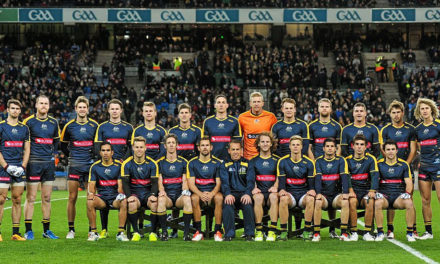Left, Gary Ablett snr. and the climax of the 1994 preliminary final. Right, AFL today, a different game altogether.
An AFL season can be a bit of a hard slog at times, particularly through the mid-season rounds, when there’s fewer games to watch although, somewhat perversely, spread across more days of the week.
The grind can catch up with everyone involved, not just the coaches and players of teams doing it tough.
Even those winning can find it difficult to muster the over-the-top enthusiasm that will come naturally when the last few rounds and September roll around, the focus more on just getting the result than the manner in which it is achieved.
The hardiest supporters, too, might find themselves suppressing the odd yawn watching another dour, low-scoring scrap even if their team ends up on the right end of the scoreboard ledger.
It’s a temporary malaise, sure to abate as the weather begins to warm again and the season’s climax draws nearer.
But what if it doesn’t? What if winter comes and goes, and the once diehard footy fan still feels like something is missing, or they notice there’s more times now when it just seems easier and preferable to watch a game on TV than make the effort to actually attend?
I’m 54 now, been living and breathing the game for close enough to 50 years, and been fortunate enough to forge a living from it indirectly for more than 35. It’s consumed an enormous amount of my life, none of which I regret.
But I’ve had my share of those moments, too, in recent times. I always end up asking myself, is it me, or is it the game? And it’s not an easy question to answer.
Every facet of the game is so different now to the one with which I grew up. Not just how it looks on the field, but the construction of the competition, even its name, the venues at which it is played, how it’s covered, what being a fan entails. The list is endless.
I’d hope I’m different, too, all these years later. Some things haven’t changed (eg. some still call my taste in music adolescent). But it would be a rare person who took on life’s big responsibilities like relationships, children and career as they got older and still had just as much emotional energy to expend on their chosen team and the game as they did when they were by and large responsibility free.
Me or the game would be a far easier question to answer if AFL football today were essentially the same product it was 30, even 20 years ago, of course. But how many sports stay the same in the face of newer technology, burgeoning corporate involvement and changes to our social structure?
Royal tennis, perhaps? I can’t think of too many others. And every argument put forward to support one side of the question has a feasible counter argument.
I feel like I watch a lot more mediocre games of AFL football than I used to. But is that simply because I watch a lot more games than I used to? It’s only been since the advent of pay TV that we had the chance to watch every game in full. And yes, there were plenty of duds in the ‘70s, ‘80s and ‘90s, too.
Strip away the outside noise (and there’s a LOT more of that these days) and the actual game is still capable of moving me to emotional heights.
I’ve been to every grand final since 1973, and last year’s epic between West Coast and Collingwood is definitely in the top handful. And Sydney’s 10-point win over Hawthorn in 2012, in the balance until Nick Malceski’s snap with only 40 seconds left on the clock, might just be the best I’ve seen.
But I’d still contend the best single game of football I have ever seen was all the way back in 1994, the preliminary final between Geelong and North Melbourne. That was defined by Gary Ablett senior’s one-handed mark in the goal square two seconds before the siren rang with scores level, but it had so much more.
Fortunes fluctuating this way and that. Incredible individual efforts, Wayne Carey’s six-goal, 14-mark, 24 disposal effort one of the greatest finals ever played. Controversy. Heaps of physicality. But still relatively open and free-flowing, rapid fire, end-to-end football that never let up from the first bounce until Ablett clinched victory for the Cats.
The single greatest season of football I’ve witnessed came the year before in 1993, a season which delivered an unexpected Essendon premiership delivered with a group of raw kids, six of whom had played only 25 or fewer senior games.
Again, though, there was so much more. A stack of memorable games it’s still easy enough to recall off the top of the head more than 25 years later. A collection of some of the greatest key forwards the game has ever seen all at the peak of their powers.
Ablett, Dunstall, Modra (each of whom kicked more than 120 goals). Lockett (who would have had he not been injured for half the season). Sumich. Kernahan. Longmire. Carey. Rocca. Lynch. Salmon.
Football in my view has never been better than in that season. And it was comfort of sorts to know it wasn’t just me donning the rose-coloured glasses when last year a production called “1993: The Greatest Season That Was” proved one of the most popular sporting podcasts in the country.
Many aficionados of the modern game get annoyed with the constant talk about low scoring, currently at just 80 points per team per game, three points less even than last year, the lowest-scoring we’d seen since 1968.
To me, though, it’s not just about the scoring, but the speed of the ball movement, the ping-ponging of play from one end to the other.
Whether it’s mainly because of vastly improved defensive strategies and positioning, you simply can’t argue that the ball didn’t once move a lot quicker than it does these days. Well, not once you hop on to YouTube and check out virtually any game from that early ‘90s period, anyway.
Games from that era, whether my team was involved or not, had me consistently on the edge of my seat and with my heart racing. I find myself that exhilarated a lot less now.
But the other stuff of which I lament the passing, the range of up to nine or 10 suburban venues to which you once travelled to watch your team rather than two or three now, the crosstown adventures on trains and trams rather than a slide into the driver’s seat of a car and parking underneath Marvel Stadium, I happily concede isn’t about the game as such, but the simple passing of time.
And perhaps it’s incumbent upon all of us of middle age and older who have seen several eras of football not to confuse changes in social habits and our own lifestyles with the actual game of Australian football.
I’m actually writing this piece shortly after a conversation over the fence with a neighbour of mine, a former AFL player of some repute who spent more than 10 years in the system for 150-odd games.
Like me, like a lot of us, he laments some of the dour, defence-oriented football he sees today. But he’s still involved with the game at grass roots level. And he has a tribe of young kids who are just as passionate about football as he or I ever were. They’re happy enough with the product. “It’s all they know,” he says.
Somehow, that makes me feel better. And perhaps more determined to enjoy the game today on its own terms. We probably owe it to those kids to do so.
*This article first appeared at INKL.












Great piece Rohan. I wonder and worry about this too. I am, for whatever reason, generally optimistic about some things now. I am especially pleased by the steady removal of the runners – having proxy coaches on-field I think created at least a footballing generation (not 25 years, more a full careers worth) of players with an inability to think, recalibrate and strategise themselves. Instead we got athletes. But I think 6-6-6, fewer rotations and lesser involvement from the coaches is starting to favour either teams with very, very strong systems (the oft-mentioned-postgame “structures”) but, cheeringly, a species that was nearly extinct: the natural footballer. Maybe not physical beasts – but players that understand space and time and movement.
Lastly, as someone living in the West, I’d also like to suggest that the game has indeed looked worse than it does now – and I’d argue that 2005/2006 GFs weren’t good games – they were close. And that is not the same thing. Stoppage-ball was TERRIBLE.